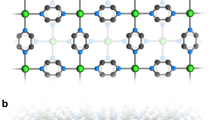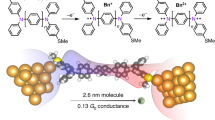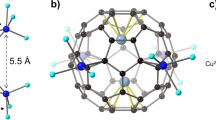Abstract
THE classical, but still recent, example of an organic metal, TTF–TCNQ, has been fully investigated and reviewed by two groups1,2. It has a room temperature electrical conductivity of ∼103 Ω−1 cm−1 which increases on cooling to a maximum, with σm/σRT ∼ 10–15, at ∼ 58 K (ref. 1), where it undergoes a metal–semiconductor transition. In 5 of 150 crystals, σm/σRT > 20–150 has been reported1. Recently3 a congener HMTSF–TCNQ (hexamethylene tetraselenafulvalinium tetracyanoquino-dimethanide) was reported to have σRT = 1,391–2,178 Ω−1 cm−1 increasing to σm/σRT ∼ 3.4 at 75–45 K, when it decreases to σ/σRT = 0.3 at 1.5 K. These organic substances showed no superconducting transition, in contrast with the inorganic polymer (SN)X which, while mostly behaving similarly4, also shows the onset of superconductivity at 0.26 K (ref. 5).
This is a preview of subscription content, access via your institution
Access options
Subscribe to this journal
Receive 51 print issues and online access
$199.00 per year
only $3.90 per issue
Buy this article
- Purchase on Springer Link
- Instant access to full article PDF
Prices may be subject to local taxes which are calculated during checkout
Similar content being viewed by others
References
Garito, A. F., and Heeger, A. T., Acct chem. Res., 7, 232 (1974).
Bloch, A. N., Energy and Charge Transfer in Organic Semiconductors (edit. by Masuda, K., and Silver, M.), 159, 167 (Plenum, New York and London, 1973).
Bloch, A. N., Cowan, D. O., Bechgaard, K., Pyle, R. E., and Banks, R. H., Phys. Rev. Lett., 34, 1561 (1975).
Che-hsiung, Hsu, and Labes, M. M., J. chem. Physics, 61, 4640 (1974).
Greene, R. L., Street, G. B., and Suter, L. J., Phys. Rev. Lett., 34, 577 (1975).
Ashwell, G. J., Eley, D. D., Wallwork, S. C., and Willis, M. R., Proc. R. Soc., A 343, 461 (1975).
Ashwell, G. J., Eley, D. D., and Willis, M. R., J. chem. Soc. Faraday Trans. II, 71, 1227 (1975).
Rembaum, A., Hermann, A. M., Stewart, F. E., and Gutmann, F., J. phys. Chem., 73, 513 (1969).
Groff, R. P., Suna, A., and Merrifield, R. E., Phys. Rev. Lett., 33, 318 (1974).
Allender, D., Bray, J.W., and Bardeen, J., Phys. Rev. B., 9, 119 (1974).
Strässler, S., and Toombs, G. A., Phys. Lett., 46 A, 321 (1974).
Weger, M., Horovitz, B., and Gutfreund, H., Phys. Rev. B., 12, 1086 (1975).
Meaden, G. T., Electrical Resistance of Metals, 15 (Heywood, London 1966).
Swingle, R. S., II, Groff, R. P., and Monroe, B. M., Phys. Rev. Lett., 35, 452 (1975).
Merrifield, R. E., Phys. Rev. Lett., 34, 877 (1975).
Author information
Authors and Affiliations
Rights and permissions
About this article
Cite this article
ASHWELL, G., ELEY, D. & WILLIS, M. Organic complex radical anion salt metallic down to 30 mK. Nature 259, 201–202 (1976). https://doi.org/10.1038/259201a0
Received:
Accepted:
Issue Date:
DOI: https://doi.org/10.1038/259201a0
This article is cited by
Comments
By submitting a comment you agree to abide by our Terms and Community Guidelines. If you find something abusive or that does not comply with our terms or guidelines please flag it as inappropriate.



